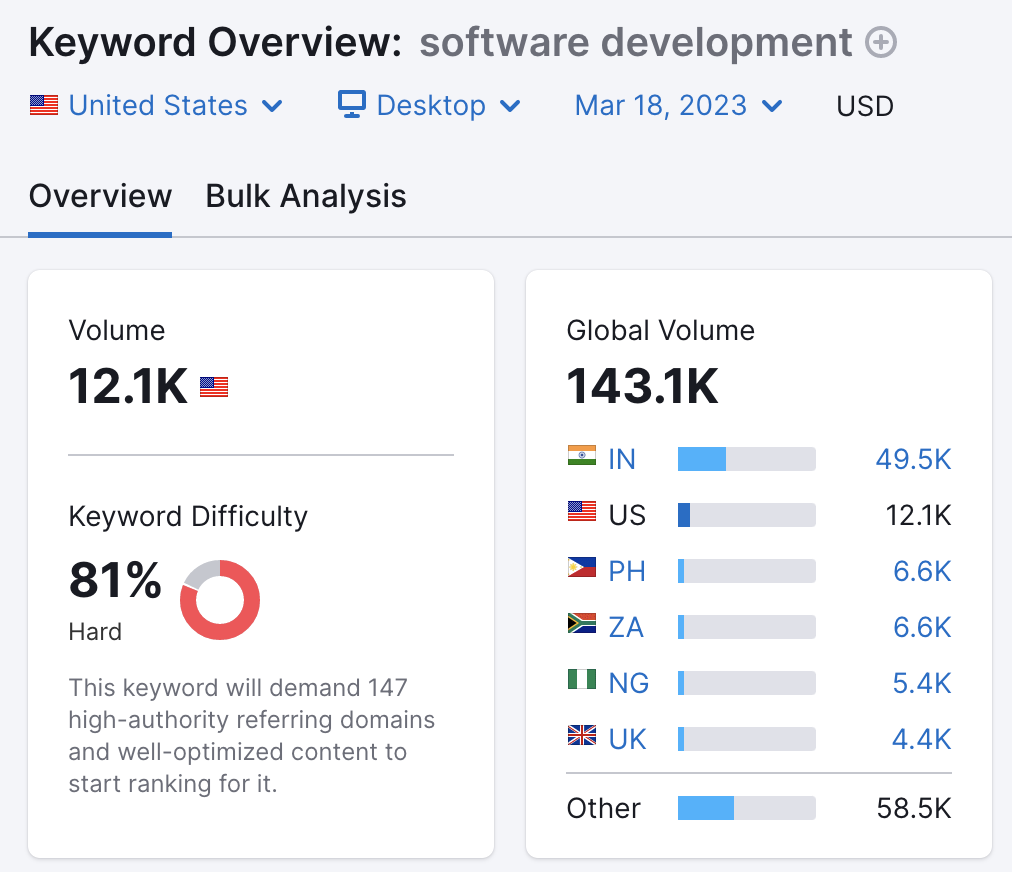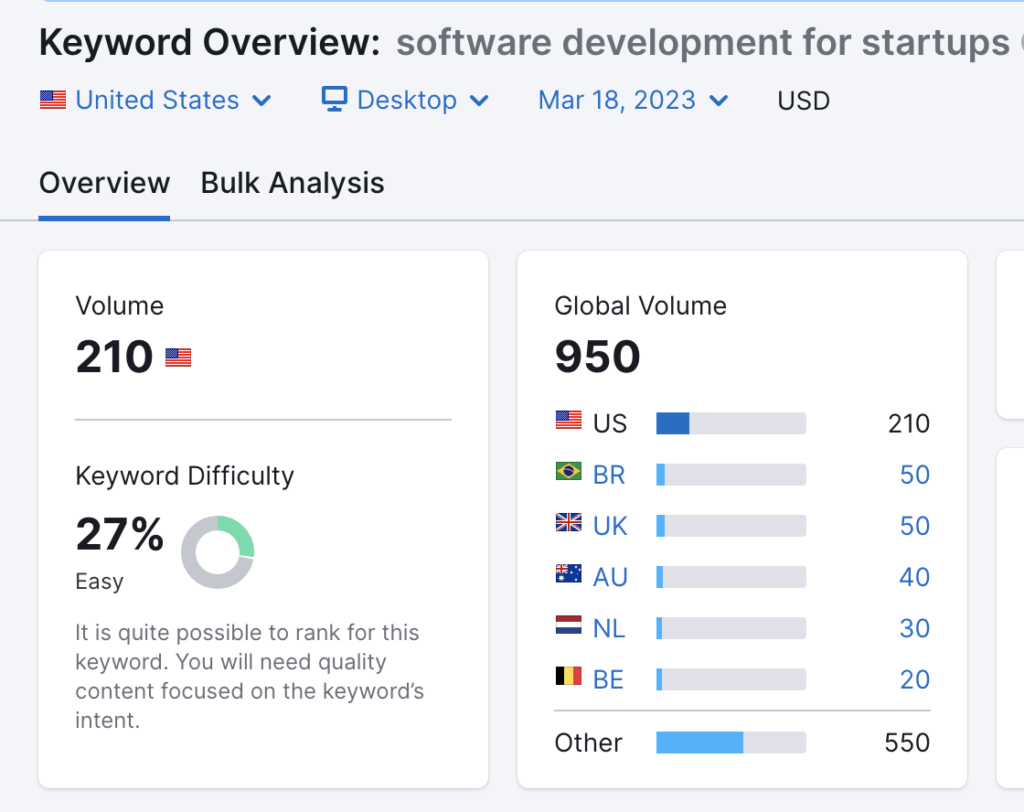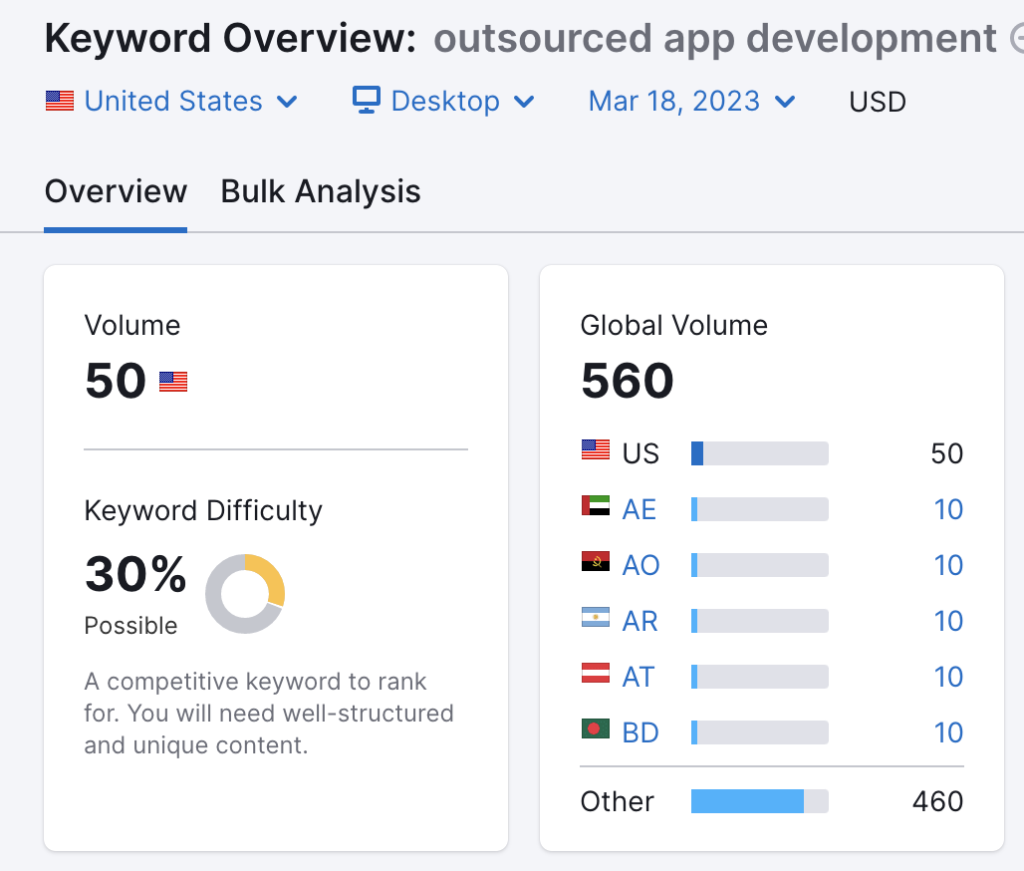What is SEO and why is it Important for Startups
Search Engine Optimization, SEO, is the process of setting your website up to rank highly in Google for keywords relevant to your business that will result in organic website traffic and organic lead generation. SEO is an excellent marketing channel because you can capture leads that are already searching for the product or service you are offering, making them high intent.
Let’s compare to some other channels to drive this concept home. Take paid advertising on Facebook, Instagram, or Linkedin, for example… You can target a specific audience on these channels with an ad, but this audience isn’t necessarily currently looking for your product or service. You are relying on your ad to be catchy enough to convince someone who didn’t have your product or service at the forefront of their mind to click on the ad. This strategy can work, but it is more difficult, and it generally has a higher cost per lead, and cost of acquisition that a channel like SEO which captures leads at the moment they are thinking about the thing you are selling.
SEO is one of the largest lead generation channels for many startups. While it may not be effective overnight and requires an investment up front, it becomes more and more effective over time, giving it the potential to grow exponentially. Even if it’s not a channel that a startup with a limited budget can afford to invest in right away, startups should still consider investing what they can, either outsourcing or in-house so that they can set a foundation for when they start at a later date.
As a startup, don’t be discouraged by the level of competition there now is on Google. If you know how to do keyword research (which we will teach in this blog), you will know exactly how to find excellent keyword opportunities for any business.
How can SEO still be effective with Limited Resources
You can still invest in SEO with limited resources and see results, you just have to be hyper focused on what you work on. SEO involves about four different skillsets, so to execute on a complete SEO strategy, you could easily hire two or three full time roles and their days would be full.
By prioritizing the most important areas of focus for SEO, you can accomplish more while doing less. Th single most important thing to get right, especially when doing SEO on a budget, is your keyword research. It’s not as simple as most believe, but it also doesn’t need to be highly complex. Let’s dive into how to do effective keyword research.
How to Research and Plan
First, there are a few important things to keep in mind when doing keyword research.
- Even if a keyword seems like a good one, it may not be. It’s critical to check it in an SEO tool. We’ll get into this later.
- Don’t pick more than one focus area to work on at a time. By focus area, I am referring to a grouping of keywords that are all variations of the same thing. ie – if the services you’re selling are web development, paid advertising, and content, choose one of these services to focus on at first, and do keyword research for only one service. If you try to focus on all of them at the same time, you may still see results, but it will take 6-9 months vs 3-4 months. This is because you are spreading your limited resources over too many areas, thus the impact is not as immediate.
Now, let’s talk about keyword research and how to do it effectively for any business. To help get some of these concepts across, I’ll use lots of examples.
Let’s say you have a software development company that builds custom software solutions. Let’s take a look at “software development” as a keyword.
You’ll notice in the screenshot that it has a very high search volume, over 12k monthly searches. However, it is highly competitive. SEMrush gives you an idea of how many referring domains you will need linking back to your site to be able to rank for this keyword. It’s a lot! This keyword is likely out of your reach if you’re a startup. If you put resources into this keyword, your payback period will be years, and possibly never, as your competition will be investing in SEO too and you may never catch up. In one year you may need 250 referring domains, instead of 147. Please don’t choose keywords like this! They will slow you down and you will miss out on other, better opportunities.
The other important thing to note for this keyword is that it is a very broad search term. This means that it is likely to have high search volume and low intent because anyone searching this term could be looking for anything, ie – looking for a definition of software development, or looking for software development technology. So, even if you did rank for this keyword and were generating organic traffic, you would likely not be generating good quality leads.

Instead, focus on longer tail keywords. These are keywords that literally include more words, which tends to make them a little more focused or niched. Once you choose a few variations within your focus area, use a free tool like SEMrush to check the monthly search volume and competition levels. You can also review the keyword suggestions that SEMrush provides within the same search.
So, going back to our example business, let’s try searching for a variation, such as “software development for startups”. This keyword is considered a long tail keyword because it has an extra word in it, making it more narrowed. This is also a great keyword because it is much higher intent. ie – most people searching this keyword are looking for software development for startups. The competition level is not nearly as high as the first keyword, and although it has significantly less search volume, it wouldn’t be hard to rank for this keyword, thus capturing some of this high quality traffic. Bingo! We’ve found a great opportunity. Add this to your keyword list and let’s move onto the next keyword.

Let’s check one more… “outsourced app development”. This is a nice, high intent, longtail keyword. Looking in SEMrush it requires a little bit of work to rank for, but still achievable. You can focus on keywords like this, but be prepared for them to take a few more months before seeing results. Again, lower search volume than those broad keywords, but once you add 10-30 of these smaller opportunities to your list and ensure they are all in the same focus area, the traffic possibilities add up to thousands of potential new high quality visits to your website.

Free and Low Cost SEO Tools
I won’t spend too much time on this, because you really only need one tool for SEO on a budget, and you’ve heard me mention it already. SEMrush has limited usage on a free plan, but it’s just enough to do some solid research. Their paid plans are also affordable so you can always upgrade. This is the only tool I use for keyword research. I also use it for website audits to find technical issues, and for content to ensure it’s well optimized for SEO.
There are other great tools out there too, like ahrefs, similar to SEMrush, and for an excellent content tool you can try ClearScope. Although Clearscope is a little pricier at around $350/month, it gives you much deeper insight into how to optimize your content than SEMrush.
On-page Optimization
Optimizing Title Tags, Meta Descriptions, and Header Tags
Optimizing title tags, meta descriptions, and header tags is an important aspect of on-page SEO (Search Engine Optimization) that can help improve the visibility and ranking of your website in search engine results pages (SERPs).
These tasks are simple, non-technical items you can and should address in any SEO campaign. It can save you a lot of time to install a plugin on your CMS that helps make these types of optimizations easier and faster. Yoast is a popular one to use. Let’s take a closer look at what each of these elements are.
Title tags, also known as meta title tags, are HTML elements that specify the title of a web page. They appear in the top bar of the browser and in the search engine results. Title tags should be concise, descriptive, and include relevant keywords that accurately describe the content of the page. It’s important to keep the title tag under 60 characters so that it is fully displayed in the search engine results page (SERP).
Meta descriptions, also known as meta description tags, are HTML elements that provide a brief summary of the content on a web page. They appear under the title tag in the SERP and should be descriptive, concise, and include relevant keywords. Meta descriptions should be under 160 characters and should also be compelling enough to entice users to click through to your website.
Header tags, also known as heading tags or H tags, are HTML elements that provide structure to the content on a web page. There are six levels of header tags, ranging from H1 to H6, with H1 being the most important. H1 tags should be used for the main heading of the page and should include relevant keywords. The H1 tag is a pretty minor change that can make a significant difference to the success of your SEO campaign. H2 tags should be used for subheadings and so on.
To optimize these elements, it’s important to do the keyword research first to identify the most relevant and popular keywords for your target audience. Then, include those keywords in the title tag, meta description, and header tags. While you do this, just make sure to keep in mind how natural and logical the addition of these keywords sound from the readers perspective. Unnatural writing or overstuffing of keywords can lead to the opposite effect and negatively impact your results.
In addition to keyword optimization, it’s also important to write compelling and relevant titles and descriptions that accurately reflect the content of the page and entice users to click through to your website. Well-written and optimized title tags, meta descriptions, and header tags can improve click-through rates, increase traffic to your website, and improve your search engine rankings.
Tips for optimizing content for both users and search engines
The content on your site, whether it’s on your product pages, service pages, landing pages, or blog pages, it’s important that the content not just be written for SEO. If content isn’t user friendly and engaging, your content won’t have a big impact. Here are some tips for your SEO optimized web content:
Your content should not only be engaging, but also informative, and answer the questions that your target audience is asking. By doing this, you’ll not only provide value to your users but also increase the chances of them sharing and linking to your content.
Next, make sure to leverage the keyword research you’ve already done and include relevant keywords in your content. But don’t overdo it, as mentioned before, keyword stuffing can hurt your rankings. Instead, try to naturally incorporate your keywords throughout your content. You will likely do this without even realizing it, but it’s good to do a review of your content that specifically focuses on your keywords so you can evaluate if minor adjustments or rewording is needed.
It’s also important to structure your content in a way that’s easy to read and scan. Use headings, subheadings, and bullet points to break up large chunks of text and make your content more digestible.
Another tip is to include multimedia such as images, videos, and infographics in your content. Not only does this make your content more visually appealing, but it can also help with SEO by increasing the time users spend on your website. Time on page can actually have a really big impact on your SEO results. Pro Tip, if you can keep your average time on page to over 4 minutes, this helps you significantly. Time on page is a signal to Google that people like your content, so naturally, it will show it more often to searchers.
Lastly, make sure your website is optimized for mobile devices. With more and more people browsing the web on their smartphones, having a mobile-friendly website is crucial for both user experience and search engine rankings.
How to use Internal Linking to Boost SEO
Internal linking is very under rated and is probably one of the easiest things you can do to optimize your website. Let me explain how internal linking should be structured.
First thing to know is what pages you want to actually boost in Google. These are typically your product or service pages where visitors will convert into leads. You then have other pages on the website such as blog content. Blog content doesn’t typically convert traffic into leads, this is not the objective or goal of blog content.
The purpose of blog content is to capture leads that are higher up in the funnel in the research stage. They aren’t necessarily ready to buy, and you shouldn’t expect them to be. Rather, see your blog as a way to introduce leads to your brand, build trust, build website authority, and increase the content on your website. All of these things will help your other SEO efforts.
Now, for linking, blogs play an important role. If you want your product pages to rank in google, be sure to include links within your blog posts to one of your service pages. This passes “SEO juice” to those high value conversion focused pages. Additionally, ensure to include links in your blogs to other blogs on your website.
Even though internal links don’t carry as much weight as external links, these links help Google understand the content on your site and map the right keywords to the right pages, so when someone searches a keyword, Google will know which page from your website to show in the Google search results. It goes a lot deeper than this, but at a surface level, this is how internal linking helps and why it’s important.
Build External Links to Increase SEO Fast
External link building is one of the most aggressive, reliable ways to increase your SEO quickly. In fact, if you have to choose between writing blog content or link building, link building will get you results faster. However, there are several important things to know about link building, because depending on how it’s done, it can just as easily hurt you as help you.
- Do not pay for links. This needs to be done through organic outreach. It’s very risky to pay for links, because this is strictly against Google regulations and if they were to find out, they could send your website down the rankings regardless of all the hard work you’ve put into your SEO.
- Watch out for link farms. These are websites that essentially have a fake Domain Authority and while you think you’re getting a good quality backlink, you’re actually getting a toxic link that will hurt your SEO
- Make sure you can commit the time. Link building is time consuming… very time consuming. Not only do you need to research relevant websites, you need to plan and run an outreach campaign, and then convince these sites to say yes to adding your backlink. Likely, you’ll need a non-monetary incentive such as some free content that includes a link to your site to convince them.
- In the case of backlinks, hiring an SEO agency makes a lot of sense. This is because a lot of SEO agencies are already set up for this organic outreach and have this process streamlined, thus making it cheaper for the client. Some agencies also offer link building only campaigns (Pro tip, we offer this), so if you want to do a lot of the SEO work internally and outsource the link building portion, it’s a good compromise that will save you money.
All in all, if there is one main point to take away from this blog, it’s to build your link profile. I’ve worked with lots of companies who have tried to improve their rankings for years through just content generation and haven’t seen any results until they started link building. Other than proper keyword research, link building is a close second in terms of importance for a successful SEO campaign.
Importance of Optimizing Images and Videos
Did you know that optimizing your images and videos can actually have a big impact on your website’s performance? Let’s break it down…
Large and unoptimized images and videos can slow down your website’s load time, which can lead to a poor user experience. Nobody likes waiting around for a website to load, am I right?
By optimizing your images and videos, you can reduce their file size without sacrificing quality, which can help speed up your website’s load time. There are plenty of free tools out there that can help you compress your images and videos, such as TinyPNG and HandBrake.
Another reason why optimizing your images and videos is important is because it can help with SEO. By adding descriptive and relevant alt tags and file names to your images and videos, you can help Google understand what your content is about and improve your chances of showing up in relevant search results.
Plus, let’s not forget about the importance of visual content in today’s digital age. People are more likely to engage with and share content that includes eye-catching images and videos. So, by optimizing your visual content, you’re not only improving your website’s performance but also increasing the chances of your content going viral.
All in all, optimizing your images and videos is an easy and effective way to improve your website’s user experience, SEO, and overall performance. So what are you waiting for? Go forth and optimize!
Outsourcing as an SEO Solution for Startups
As mentioned above, you could easily make SEO a full time job for at least 3 people, simply because the skillsets required are so different and you’re not likely to find someone who has the expertise in all of them.
If you don’t have the resources, you have two options:
- Do SEO in-house
- Outsource SEO to an agency, like us
Both options are good, but I like the second option better. I’ll tell you why…
With an agency, they usually have those three full time people with different skillsets and you, as the client, gets access to all 3 for the price of one. It’s win-win, because you don’t need to rely on one person in-house to know and understand the technical, content, and link building side of SEO. If you’re looking for an SEO agency for startups, you’ve come to the right blog, and website. Helping startups get SEO results within a short amount of time is what we do… and you won’t break the bank. Contact us here.


